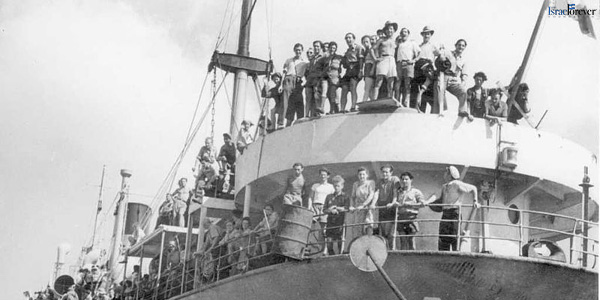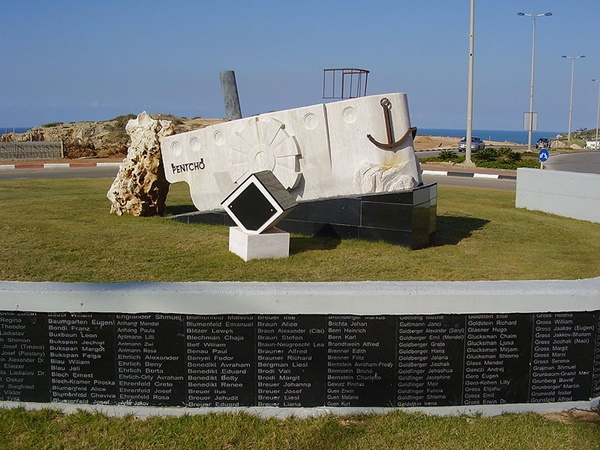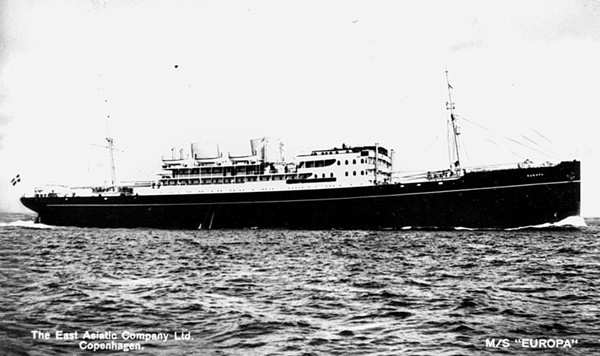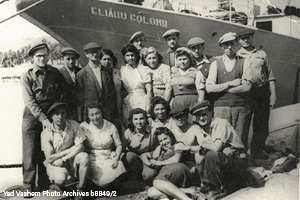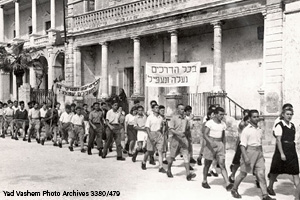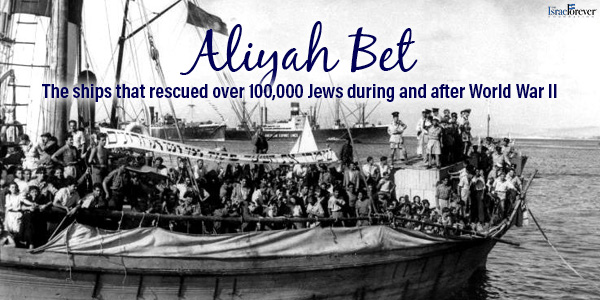Aliyah Bet Timeline
Tags: Aliyah, History, Holocaust, Immigration, Exodus
- In 1934, the first attempt to bring in a large number of illegal immigrants by sea happened when some 350 Jews sailed on the Vallos, a chartered ship, without the permission of Jewish Agency, who feared illegal immigration would cause the British to restrict legal immigration. She arrived off the coast of Palestine on August 25, and the passengers disembarked with the help of the Haganah, which received special permission to assist them.
- The Tiger Hill, a 1,499 ton ship, built in 1887, sailed from Constan?a on August 3, 1939, with about 750 immigrants on board. She took on board the passengers from the Frossoula, another illegal immigrant ship that was marooned in Lebanon. On September 1, the first day of World War II, the Tiger Hill was intercepted and fired on by Royal Navy gunboats off Tel Aviv, and was beached.
- On November 24 and 25, 1939 a large group of immigrants travelled by train from Vienna to Bratislava and about 10 days later sailed from there on the riverboat Uranus down the Danube. At the Romanian border, the three smaller riverboats to which they had been transferred on December 14 on entering Yugoslavia were intercepted and the immigrants were forced to disembark at the old fortress town of Kladovo. About 1,100 refugees were stranded there. In May, 1941, they were still in Yugoslavia, where 915 of them were caught and eventually killed by the invading Nazis.
- On May 18, 1940 the old Italian paddle steamer Pencho sailed from Bratislava, with 514 passengers, mostly Betar members. The Pencho sailed down the Danube to the Black Sea and into the Aegean Sea. On October 9 her engines failed and she was wrecked off Mytilene, in the Italian-ruled Dodecanese Islands. The Italians rescued the passengers and took them to Rhodes. All but two were then placed in an internment camp at Ferramonti di Tarsia in southern Italy. They were held there until Allied forces liberated the area in September 1943. The story of the Pencho was published as Odyssey, by John Bierman.
- In October 1940 1,770 Jewish refugees sailed from Tulcea to Haifa in two ships. The Pacific arrived off Haifa on November 1, followed a few days later by the Milos. The Royal Navy intercepted each ship and escorted it into Haifa, where British authorities detained the refugees before transferring them to a requisitioned French ocean liner, the Patria, for deportation to Mauritius. They were followed from Tulcea by another 1,634 refugees aboard the Atlantic, which arrived on November 24 off Haifa, where the Royal Navy escorted her into harbour. On November 25 the British had just started transferring Atlantics refugees to Patria when Haganah agents planted a bomb aboard the French liner with the intention of disabling her to prevent her from sailing. However, the bomb quickly sank Patria, killing 260 people and wounding 172. The survivors were allowed to stay in Palestine on humanitarian grounds.
- In October 1940 a large group of refugees were allowed to leave Vienna. The exodus was organized by Berthold Storfer, a Jewish businessman who worked under Adolf Eichmann. They took four river boats, Uranus, Schönbrunn, Helios, and Melk, down the Danube to Romania, where the Uranus passengers, about 1,000, boarded the Pacific, and sailed on October 11, 1940. They arrived at Haifa on November 1, followed by the Milos. The British transferred all the immigrants to the French liner SS Patria to take them for internment to Mauritius. To stop the Patria from sailing, the Haganah smuggled a bomb aboard. The explosion holed her side, capsizing her and killing 267 people. The British, by order of Winston Churchill, allowed the survivors to remain in Palestine.
- In December 1940 the Salvador, a small Bulgarian schooner formerly named Tsar Krum, left Burgas with 327 refugees. On December 12 the Salvador was wrecked in a violent storm in the Sea of Marmara, near Istanbul. 223 persons, including 66 children, lost their lives. The survivors were taken to Istanbul. 125 survivors were deported back to Bulgaria, and the remaining 70 left on the Darien (No. 66).
- On December 11, 1941 the Struma sailed from Constan?a carrying between 760 and 790 refugees. Three days later she reached Istanbul, where Turkey detained her and her passengers for 10 weeks. On February 23, 1942 Turkish authorities towed her back into the Black Sea and cast her adrift. Early the next day the Soviet submarine Shch-213 torpedoed and sank her. Between 767 and 791 people were killed, and there was only one survivor.
- On September 20, 1942 the Europa sailed from Romania with 21 passengers. She was wrecked in the Bosphorus.
- On August 5, 1944 Bulbul, Mefküre and Morino sailed from Constan?a carrying about 1,000 refugees between them. In the night the Soviet submarine Shch-215 sank Mefküre by torpedo and shellfire, and then machine-gunned survivors in the water. Between 289 and 394 refugees plus seven crew were aboard Mefküre; only the crew and five refugees survived. Bulbul rescued the few survivors and took them to Turkey.
- On April 21, 1944 the "Belasitza" sailed from Romania with 273 passengers including 120 children, who went from Istanbul to Palestine by sealed train.
- On August 28, 1945 the Italian fishing vessel Dalin, made in Monopoli, carrying 35 immigrants, landed at Caesarea, disembarked its passengers, and returned to Italy.
- On September 4, 1945 the ship Natan, carrying 79 immigrants, landed in Palestine. It carried seamen and radio operators from the Palmach and Jewish Agency emissaries on the return trip to Italy. On October 1, 1945, the Natan again ran the blockade arrived at Shefayim with 73 immigrants.
- On September 9, 1945 the Gabriela, carrying 40 passengers, arrived undetected in Palestine.
- On September 17, 1945 the Peter, carrying 168 immigrants, landed in Palestine undetected by the British. She again slipped into Palestine undetected and arrived at Shefayim on October 22, this time carrying 174 passengers.
- On November 23, 1945 the Berl Katznelson, carrying 220 Jewish refugees, arrived in Shefayim. As the ship was landing immigrants she was intercepted by the Royal Navy sloop HMS Peacock. Of the passengers, 200 reached the beach and escaped, and 20 were arrested.
- On December 14, 1945 the ship Hannah Senesh, carrying 252 passengers, was beached at Nahariya after evading Royal Navy patrols. The passengers were brought ashore via a rope bridge, and evaded capture.
- On January 17, 1946 the Enzo Sereni, carrying 908 passengers, was intercepted by the destroyer HMS Talybont and escorted to Haifa.
- On March 13, 1946 the schooner Wingate, carrying 248 passengers, ran the blockade and attempted to land. British Palestine Police opened fire from the shore, killing a female Palmach member. The ship was then captured and escorted to Haifa by the destroyer HMS Chevron.
- On March 27, 1946 the steamer Tel Hai, carrying 736 passengers, was intercepted by the destroyer HMS Chequers 140 miles out at sea as it approached Palestine.
- On May 13, 1946 the ship Max Nordau, carrying 1,754 immigrants, was captured by the destroyers HMS Jervis and HMS Chequers. The same day, the ships Dov Hos (675 passengers) and Eliahu Golomb (735 passengers) arrived in Palestine legally. The British had blockaded the Dov Hosafter it had arrived in La Spezia, but the passengers responded with a hunger strike and a threat to blow her up, compelling the British to give them entry permits.
- On June 8, 1946 the Haviva Reik, carrying 462 passengers, was intercepted by HMS Saumarez on June 8, 1946. Some 150 people had previously transferred from the Haviva Reik to the Rafi off the Palestinian coast, and the crew had disembarked.
- On June 26, 1946 the Josiah Wedgwood, carrying 1,259 passengers, was intercepted by HMS Venus.
- On July 20, 1946 the Haganah, carrying 2,678 passengers, departed from France, and transferred 1,108 of its passengers to the small steamer Biriah west of Crete. The Biriah was intercepted by HMS Virago on July 2. The Haganah picked up a new party of refugees at Bakar, Yugoslavia, and set sail for Palestine, this time also carrying 2,678 passengers total. She was found at sea with its engines broken down and no electrical power, and was towed to Haifa by HMS Venus. Her passengers were arrested and interned.
- On August 11, 1946 the Yagur, carrying 758 passengers, was intercepted by the destroyer HMS Brissenden, with passive resistance from the immigrants.
- On August 12, 1946 the Henrietta Szold, carrying 536 passengers, was intercepted. The same day, the British announced that illegal immigrants would be sent to Cyprus and other areas under detention. The first British deportation ship sailed for Cyprus on the same day, with 500 illegal immigrants on board.
- On August 13, 1946 two immigration ships were intercepted: Katriel Jaffe (604 passengers) by HMS Talybont, and Twenty Three (790 passengers) by HMS Brissenden. There was desperate resistance on board Twenty Three. The same day, two British ships with 1,300 Jewish detainees on board set sail for Cyprus. A crowd of about 1,000 Jews attempted to break into the Haifa port area, and British troops responded with live fire, killing three and wounding seven.
- On August 16, 1946 the yawl Amiram Shochat, carrying 183 passengers, evaded the British blockade and landed near Caesarea.
- On September 2, 1946 the Dov Hos, this time named the Arba Cheruyot, carrying 1,024 passengers, was seized by the destroyers HMS Childers and HMS Chivalrous. The boarding was strongly resisted, and two people drowned after jumping off the ship.
- On September 22, 1946 the brigantine Palmach, 611 passengers, was seized by the minesweeper HMS Rowena. The Royal Navy tried to board the ship four times before finally seizing her, and one passenger was killed.
- On October 19, the Latrun (1,279 passengers), was intercepted by HMS Chivalrous and the minesweeper HMS Octavia. Four people had died en route, and the ship was leaking and listing heavily when she was intercepted.
- On October 20, 1946 the Eliahu Golomb, renamed the Braha Fuld, carrying 806 passengers, was captured off Lebanon by the destroyer HMS Chaplet and minesweeper HMS Moon.
- On November 9, 1946 the HaKedosha (600 passengers), foundered in a gale and sank. The passengers were rescued by the Knesset Israel. The Knesset Israel, carrying a total of 3,845 passengers, was intercepted by the destroyers HMS Haydon and HMS Brissenden and minesweepers HMS Octavia and HMS Espiegle and taken to Haifa. The interception met no resistance, but in Haifa when the British tried to transfer them to transport ships to take them to Cyprus the refugees resisted fiercely, two were killed and 46 injured.
- On December 5, 1946 the Rafiah (785 passengers), was wrecked on Syrina Island in bad weather. The survivors were rescued by two Royal Navy and one Greek warship, and were taken to Cyprus. Women and children were taken to Palestine.
- On February 9, 1947 the wooden brigantine Lanegev (647 passengers) was captured by HMS Chieftain after a battle which left one refugee dead.
